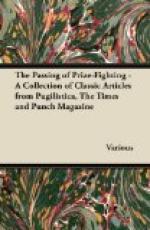* * * * *
The amateur of lace, whether as expert or owner, will be pleasantly stirred by learning that another book has been added to the already large bibliography of a fascinating subject in The Romance of the Lace Pillow (H.H. ARMSTRONG), published at Olney from the pen of Mr. THOMAS WRIGHT. Olney, of course, has two claims on our regard—COWPER and Lace, and it is now evident that Mr. WRIGHT has kept as attentive an eye on the one as on the other. His book makes no pretence to be more than a brief and frankly popular survey of the art of lace-making chiefly in Northamptonshire and Bucks, and to it he has brought a wealth of various information (which the average reader must take on trust) and an enthusiasm that can be judged by his opening statement that “lace ... is the expression of the most rapturous moments of whole dynasties of men of genius.” So now you know. Even those of us who regard it with a calmer pulse can take pleasure in the many excellent photographs of lace-work of different periods and schools that adorn Mr. WRIGHT’S volume. As for the letter-press, though I will not call the writer’s style wholly equal to his zeal, his chapters are full of interesting gossip, ranging from the late KATHERINE OF ARAGON (the originator, according to one theory, of English lace-making), to some jolly stuff on the literature of Bobbins and the old Tells, or working-songs, sung by “the spinners and the knitters in the sun, and the free maids that weave their threads with bones.” I have a fancy that the whole volume has been more or less a labour of love (never certainly did I meet an author with such a list of helpers to thank), so I am glad to think that its reward in one sense is already assured.




